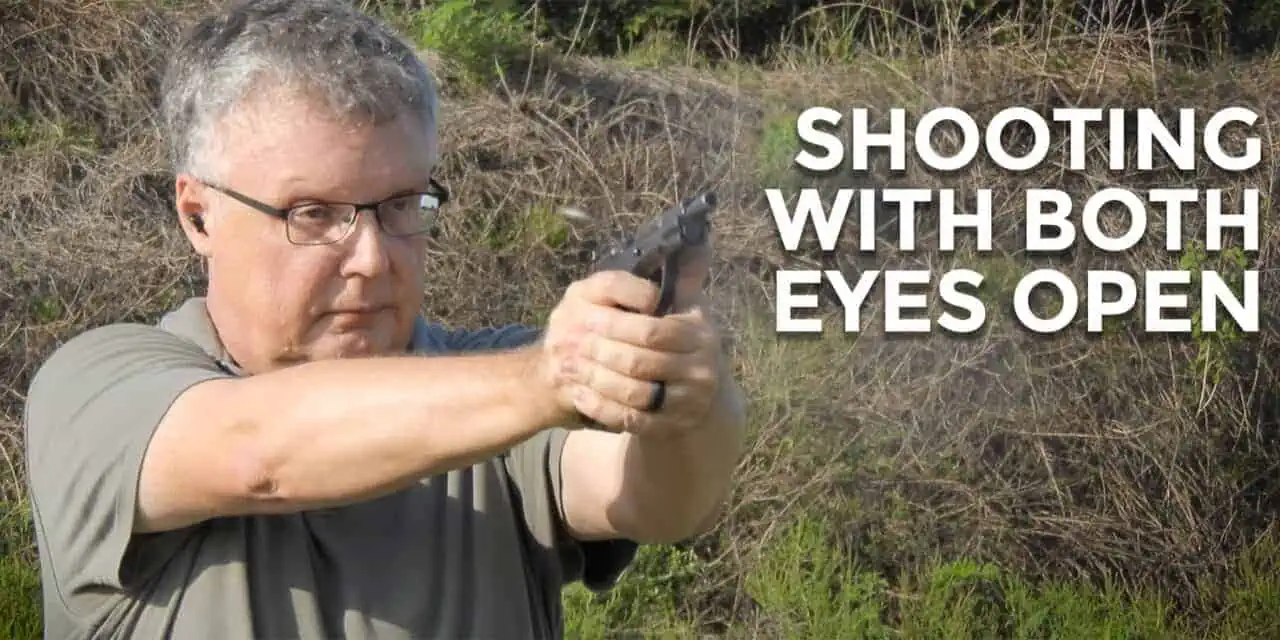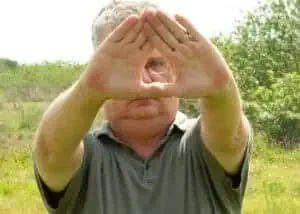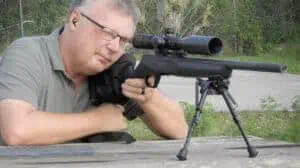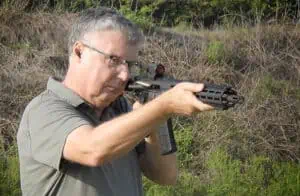How Important Is Shooting With Both Eyes Open?
Take just about any basic shooting class, and they’ll tell you that one of the keys to marksmanship is acquiring your sights and keeping them aligned on the target. What instructors rarely teach, however, is why you want to learn to shoot with both eyes open. We humans are gifted with binocular vision. We perceive our environment better when we use both eyes to look around. Our depth perception and field of vision are greater when we use both eyes, which are two things that come in very handy when a life is on the line. Therefore, perfecting the art of shooting with both eyes open is an important step in your defensive firearms journey.
Eye Spy With My Dominant Eye
Let’s begin the process of shooting with both eyes open with talking about how your eyes work. Our brain prefers to process information from one eye over the information from the other eye. The eye that the brain prefers is considered to be our dominant eye. Because our brain prioritizes information from our dominant eye over the other eye, that is the eye that we should use when we line up our sights.
Finding your dominant eye is relatively easy. Pick a point in the distance, at least a few yards away. Extend your arms out and make a “V” with both hands around the object you’ve chosen. Slowly move your arms backwards until they touch your face. As you move your hands back, you’ll find that your hands are drawn to one eye over the other. That eye is your dominant eye, and it will be always open as you shoot your gun. It’s the other eye that causes problems.
When is Shooting With Both Eyes Open A Good Idea?
Keeping both eyes open while shooting is a good idea when there are other things besides precise accuracy that are important. That may seem strange, but there are good reasons why this is so. There are also situations where closing one eye during shooting makes a lot of sense which we’ll go into later.
Shooting with both eyes open is especially important if you’re training with a defensive firearm. We have a tendency to lose our peripheral vision during the stress of a defensive encounter. If someone is attacking us, we place our concentration on the threat, and what’s around us fades into obscurity. This is a good thing. It allows us to focus on the task at hand, which is not getting killed. However, it does leave us open to being blindsided because we are not paying attention to our surroundings. This is even more so if we close one eye when shooting a gun. The bottom line is, if you’re shooting to save a life, you should be shooting with both eyes open.
When Shooting With Both Eyes Open Is Not A Good Idea
If your immediate concern is hitting the very center of the bullseye in a shooting match or making a difficult shot with a precision rifle, it isn’t important to shoot with both eyes open. These sort of shots require all our concentration, and closing one eye to remove unneeded distractions makes a lot of sense with these sort of shots. In fact, in some sports, such as Olympic-level precision pistol and rifle competitions, it’s quite common to see competitors wear a patch over one eye to force them to aim their gun with just one eye.
Tips to Help You Shoot With Both Eyes Open
I have found that most people have difficulty shooting with both eyes open when they are shooting a pistol. This makes sense, because the distance from the front sight to rear sight is often quite short in a pistol. This short distance, and the fact that you can usually see the sights with both eyes at the same time. This makes it difficult for some people to concentrate on what the dominant eye is seeing. There is often a “ghost” image of the front and rear sight in your field of view. This is created from your non-dominant eye also seeing your pistol sights.
Learning to ignore the ghost image of the sights from your non-dominant eye takes time and effort. One thing I have that can help your brain to learn how to filter out the sight input from your non-dominant eye is to do regular dry-fire practice with your pistol. In my case, my brain got used to seeing my sights align with my dominant eye as I pressed my gun out towards the target.
A proper draw technique is also important to shooting with both eyes open. Your dominant eyes should pick up the sights in your lower peripheral vision as you press your pistol towards the target. If that’s not happening, you may need to adjust how you point your gun towards the target on the draw. Your pistol should be level and flat on its way out so your dominant eye can naturally pick up the sights as they appear. If that doesn’t work, it may be time for a hardware solution.
Better Sights Equal A Better Sight Picture
If you’ve read some of the pistol reviews I’ve done on this site, you may have noticed that I am not a fan of the three dot sights that are common on a lot of pistols. On a three dot sight, there is a dot on the front sight and one dot each of the blades of the rear sight. The theory here is that your eyes will naturally want to align all three dots which will put your pistol on target.
The reality is somewhat different, at least for me. My eyes have difficulty determining which of the three dots is most important (spoiler alert: It’s the front one). As a result, I waste valuable fractions of a second sorting out my sight picture. This, in turn, makes me want to close one eye on the draw stroke, which we’ve already determined is a bad idea.
I’ve solved this problem of having my eyes bounce back and forth by switching to sights which have a very noticeable dot up front with a blank, featureless rear sight. Now my dominant eye sees just the front sight as I press my pistol out to the target. This, in turn, reduces my draw time and reduces my confusion over my sight picture during the draw.
Rifles
As I’ve mentioned before, shooting with just one eye open is quite common when making a long-distance rifle shot. However, there are many occasions when shooting with a rifle with both eyes open makes a lot of sense. A rifle is useful at almost any angle, not just long distances. When we use a rifle at closer ranges, all the reasons why keeping both eyes open suddenly come into play. Whether it’s in a 3 Gun match or while clearing a room, keeping both eyes open makes it easier to see your environment and react to changing situations.
Using the right optic is a big part of being able to keep both eyes open when using a rifle in close quarters. Red dot sights and low power variable optics (LPVO) scopes are the solutions of choice for both competitors and tactical operators. A red dot sight is a one power optic which uses a laser or LED to create a red (or green) dot inside the sight. The aiming dot is projected into the housing of the sight and is visible by just the dominant eye. Because it’s just one power, the sight picture inside the housing mimics what the other eye is seeing. This allows us to keep both eyes open when shooting.
An LPVO, on the other hand, is a telescopic sight with a limited magnification range. A typical LPVO starts out at one power, allowing you to use the crosshairs in the optic to engage targets at closer distances. At one power, a low power variable optic has the same magnification as normal eyesight. This makes them easy to use with both eyes open. However, they can quickly zoom out to 4 power and beyond to engage targets at longer distances if needed.
Getting the knack of shooting with both eyes open
To be clear, you can enjoy the shooting sports, and still keep one eye closed all the time. However, shooting with both eyes open saves you time on the draw, lets you engage targets faster and keeps you safer when lives are on the line. Learning how to keep both eyes open as often as possible when shooting takes some work to accomplish, but it pays off with better marksmanship and faster hits when speed is of the essence.





